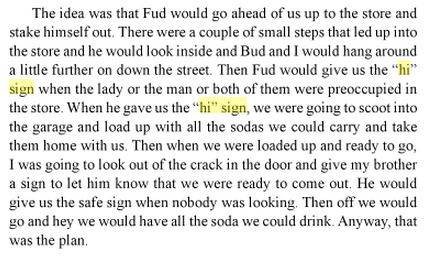The hi sign
« previous post | next post »
Reader ESM sent in a link to David Weigel, "Democrats Say They Have the Votes for Filibuster Reform, and for the 'Nuclear Option'", Slate 1/22/2013:
…even if you're a reformer, do you think there's ANY filibuster reform that wouldn't be interpeted by the Rand Paul-Mike Lee-Tim Scott-Ron Johnson quartet as the hi sign to "blow up the Senate"?
and asked
I'm curious about the use of "hi sign." I've heard the phrase spoken, but always understood it as "high sign." A quick search online didn't turn up any meaningful commentary, even of the speculative or anecdotal variety.
Merriam-Webster spells it "high sign" with the gloss: "a gesture used as a signal (as of approval or warning) — usually used in the phrase give the high sign". The OED gives the gloss "n. colloq. a surreptitious sign indicating that all is well or that the coast is clear". The AHD gives "A prearranged signal intended to warn or inform".
Presumably Mr. Weigel's spelling an eggcorn, rather than a conscious pun as in this usage by Anne Dingus, "Texas Primer: The Hi Sign", Texas Monthly June 1985:
Texas’ motto is “Friendship,” and Texas’ highways cover more miles than any other state’s, and the intersection of these two facts is the hi sign, the laconic one-finger wave shared by rural travelers. In the days of the open range, when pioneers saw another wagon of lonely wayfarers on the trackless plains, they could always rein up and chat awhile. But we modern Texans travel 55 miles an hour—at the very least—and can barely slow down for a pit stop. Thus the hi sign was born. By using it, we convey our goodwill to our fellow drivers and reaffirm our reliance on each other during long trips across isolated country. The hi sign is strictly a highway courtesy, an automotive gesture developed for the modern age. A person on horse or on foot raises his whole hand, but the demands of travel on wheels dictate a specialized wave.
If Mr. Weigel has eggcorned high sign, he's not the first to take that step — here's a paragraph from Nellie Altamirano-Bustillos, The Gardens, 2005:

John said,
January 23, 2013 @ 2:28 pm
I always understood high sign as a railroad term telling the engineer to apply power and move the engine. The flag or lantern is held high over one's head. http://www.docstoc.com/docs/24475548/Railroad-Hand-Signals
cameron said,
January 23, 2013 @ 2:54 pm
"The High Sign" is also the title of a 1921 comedy short by Buster Keaton. The sign in question is a hilarious gesture used as a signal of mutual recognition by the members of a street gang called The Blinking Buzzards.
Charles Matthews said,
January 23, 2013 @ 3:47 pm
When I was a teenager in the '50s, giving someone the high sign meant a one-finger salute, but it was the middle finger.
Lucy Kemnitzer said,
January 23, 2013 @ 5:02 pm
I don't know what came first, of course, but my understanding is the same as John's. My dad was a brakeman when I was young, and I think I remember a gesture like that among the ones he would use around home (only without the lantern in hand, of course).
KWillets said,
January 23, 2013 @ 6:59 pm
Highball has the same meaning.
Nathan said,
January 23, 2013 @ 7:17 pm
I thought "high sign" came from Freemasonry.
MikeA said,
January 23, 2013 @ 7:29 pm
Possibly refers to laughter in Morse Code (…. ..)
Need I add the modern equivalent :-)?
Tom Ace said,
January 23, 2013 @ 11:07 pm
The Little Rascals (a.k.a. Our Gang) had their own form of hi sign; seeanswers.yahoo.com/question/index?qid=20070529000638AAc8NWZand also this animated gif.
Jesse Achtenberg said,
July 29, 2014 @ 1:33 pm
I had never made this connection, but listening to the audiobook of "Bottom of the 33rd," just heard author Dan Barry referring to Red Sox player Wade Boggs making the "Chai Sign." Chai is the Hebrew word meaning "Life" and has been used as a luck symbol for hundreds of years. It is pronounced "Hi." Seems like a very plausible origin.